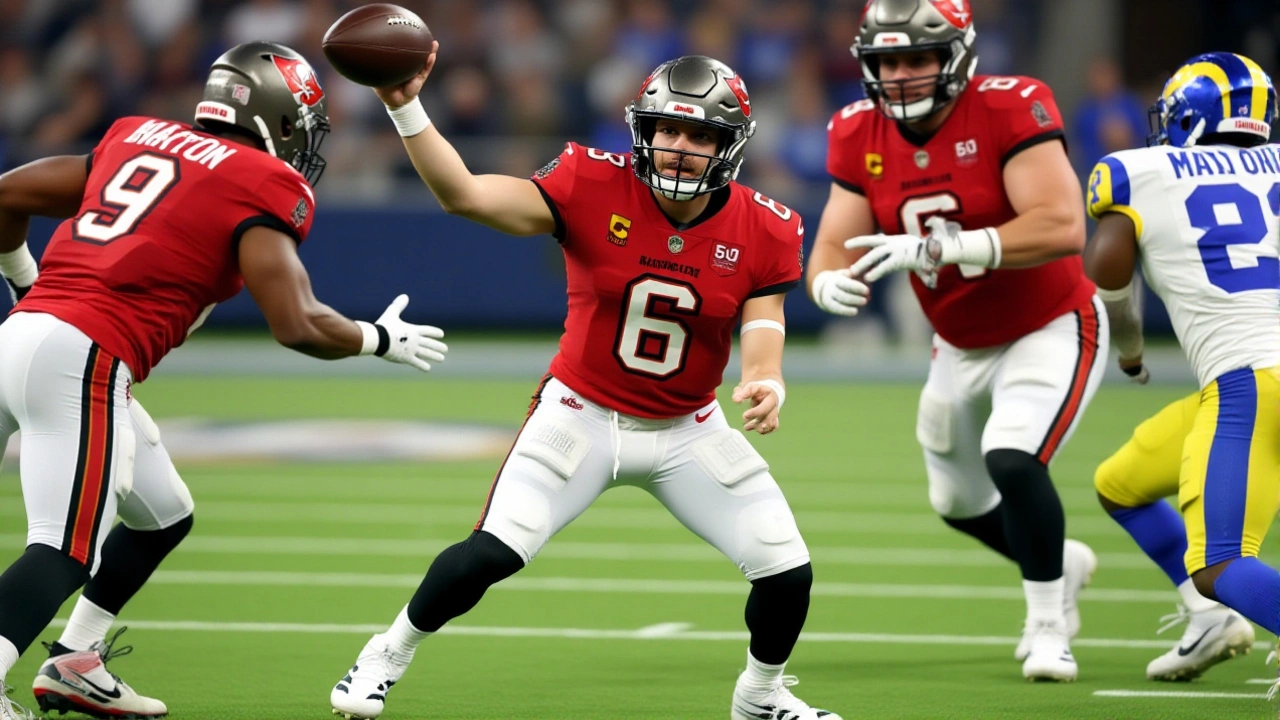When Baker Mayfield limped off the field at SoFi Stadium on Sunday night, the Tampa Bay Buccaneers’ playoff hopes took a sudden, painful turn. The 29-year-old quarterback, who signed a three-year, $100 million extension in March 2023, suffered a left shoulder sprain during the second quarter of Tampa Bay’s 34-7 loss to the Los Angeles Rams on November 24, 2025, and didn’t return. The injury — to his non-throwing arm, no less — is a chilling echo of his 2021 season with the Cleveland Browns, when he tore the labrum and fractured the same shoulder. Now, with the Buccaneers clinging to a one-game lead in the NFC South, the question isn’t just whether Mayfield will play again this season… it’s whether he’ll be the same player when he does.
How the Injury Unfolded
It started innocuously enough. At the 7:12 mark of the second quarter, Mayfield hit wide receiver Tez Johnson for a 14-yard touchdown, his only highlight of the night. Moments later, he winced, clutched his left arm, and walked to the sideline medical tent. He returned for the next drive, but the damage was already done. With 15 seconds left in the half, he launched a desperation Hail Mary — a play he shouldn’t have even attempted — and was intercepted by Rams cornerback Emmanuel Forbes Jr.. Mayfield collapsed to his knees, grimacing, then slowly trudged to the locker room. He didn’t reappear until the third quarter, wearing a sling and watching from the bench as Teddy Bridgewater took over.Mayfield finished 9-of-19 for 41 yards, one TD, two picks, and rushed four times for 19 yards. The numbers are ugly, but they don’t tell the full story. The Buccaneers’ offense, ranked 12th in the league entering the game, managed just 110 total yards before he exited. The Rams, led by Matthew Stafford and head coach Sean McVay, turned Tampa Bay’s defense — which had allowed just 24.3 points per game this season — into a sieve, scoring 31 points in the first half alone.
Coach Bowles’ Tough Truth
Todd Bowles, the 51-year-old head coach of the Tampa Bay Buccaneers, didn’t sugarcoat it after the game. "He hurt it earlier, said he was fine, he went back and then reaggravated it on the last play," Bowles said at his 11:30 PM press conference. "That’s not the kind of toughness you want to see. That’s the kind of toughness that gets you hurt worse."But Bowles also praised Mayfield’s grit. "He’s a competitor. He wanted to be out there. That’s why he’s our guy." Still, the decision to let him return was questionable. Medical staff typically don’t clear quarterbacks to throw after a shoulder sprain — especially one with prior surgical history. The fact that Mayfield attempted a Hail Mary suggests he was either misinformed… or refusing to admit how bad it was.
The Ghost of 2021
This isn’t Mayfield’s first rodeo with a broken shoulder. In 2021, while with the Cleveland Browns, he played through a torn labrum and fractured non-throwing shoulder for weeks before finally undergoing surgery in January 2022. He missed the final three games that season, then spent the entire 2022 offseason rehabbing. His performance dipped sharply after the surgery — and he was traded to Tampa Bay in March 2023 after the Browns opted to move on.Now, he’s back in the same physical territory. And this time, he’s not just fighting for a roster spot — he’s fighting for a playoff berth. The Buccaneers entered the game at 7-4, leading the NFC South by a game over the New Orleans Saints. A loss to the Rams wasn’t just a setback — it was a signal that their window might be closing. Without Mayfield, their offensive identity evaporates. Bridgewater is a steady hand, but he’s not a playmaker. And the Buccaneers’ offensive line? It’s been a sieve all season.

What’s Next? The Clock Is Ticking
Mayfield is scheduled for an MRI on Monday, November 25, 2025. The initial diagnosis — a sprain — suggests 2 to 4 weeks of recovery. But with his history, that timeline could stretch to six weeks or more. If he’s out for the next two games — including the crucial Week 13 matchup against the Arizona Cardinals on December 1, 2025 — the Buccaneers will likely elevate third-string QB Connor Bazelak from the practice squad.That’s not a recipe for a playoff run. The Cardinals are 6-5 and coming off a win over the 49ers. They’ll attack Tampa’s defense with tempo, knowing Bridgewater won’t be able to match their energy. And if the Bucs lose again, they’ll fall behind the Saints and possibly the Washington Commanders — both teams with momentum.
There’s a deeper worry, too. Even if Mayfield returns, will his arm be the same? Will he trust his shoulder to throw a deep ball? Will he hesitate before stepping into a throw? That’s the real cost of this injury — not the missed games, but the mental toll.
What This Means for the NFC South
The NFC South is a dogfight. The Saints, Falcons, and Panthers are all within striking distance. Tampa Bay’s lead was slim to begin with. Now, with their franchise QB possibly sidelined, the division could flip overnight. If Mayfield misses even one game, the pressure on Bridgewater — and the entire offense — becomes unbearable.And let’s not forget the clock. The Buccaneers have just five games left. Two of them are against division rivals. If they’re not at full strength by Week 15, their playoff chances vanish.
Frequently Asked Questions
How serious is Baker Mayfield’s shoulder injury compared to his 2021 injury?
While this is currently diagnosed as a sprain — not a tear — the fact that it’s the same non-throwing shoulder that suffered a labrum tear and fracture in 2021 raises red flags. That prior surgery weakened the joint’s stability, making it more vulnerable. Even a minor sprain could lead to prolonged inflammation or re-injury if he returns too soon. Medical sources suggest recovery could take 4-6 weeks instead of the typical 2-4, especially if imaging shows lingering scar tissue.
Who is Teddy Bridgewater, and can he carry the Buccaneers’ offense?
Teddy Bridgewater, 31, is a veteran known for efficiency over explosiveness. He’s started 48 NFL games and has a 64.7% career completion rate. But he’s not a deep-ball threat — he averaged just 6.8 yards per attempt last season. The Buccaneers’ offense relies heavily on Mayfield’s ability to stretch the field. Without that, the team will lean on the run game and short passes, which won’t be enough against elite defenses. Bridgewater’s best chance is if Tampa’s defense forces turnovers.
What’s the timeline for Mayfield’s potential return?
The earliest Mayfield could return is Week 14 against the Atlanta Falcons on December 8, 2025 — assuming the MRI shows no structural damage. But given his history, the Buccaneers will likely err on the side of caution. A return in Week 15 or 16 — against the Panthers or Saints — is more realistic. He’ll need to pass a full-contact practice before being cleared, and that’s unlikely before mid-December.
Could Connor Bazelak get playing time even if Mayfield returns?
Possibly. Bazelak, a 2023 undrafted free agent, has shown poise in practice and was active for two games this season. If Mayfield returns but looks rusty or hesitant, the coaching staff might give Bazelak a series or two to see if he can spark the offense — especially in high-leverage situations. It’s not unheard of for teams to rotate quarterbacks mid-game if one is struggling.
How does this affect Tampa Bay’s playoff chances?
Tampa Bay’s playoff odds dropped from 68% to 31% immediately after the loss, per FiveThirtyEight’s NFL model. Without Mayfield, their offense ranks near the bottom of the league in scoring efficiency. Even with Bridgewater, they’d need to win all remaining games — and get help from other teams — to make the playoffs. The Saints, who play the Buccaneers in Week 17, now hold the tiebreaker advantage. This injury may have ended their season before it even got to the postseason.
Why didn’t the team just bench Mayfield after the first injury?
That’s the big question. Mayfield is known for playing through pain — he did it in college, in Cleveland, and even last season with a hip issue. The team’s medical staff may have cleared him based on his insistence he was fine. But NFL teams are increasingly being criticized for letting players return too soon. This incident could spark a league-wide review of sideline injury protocols, especially for quarterbacks with prior shoulder surgeries.





